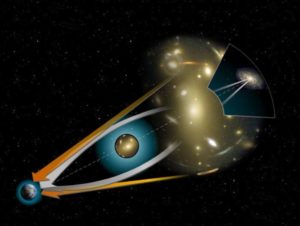Editor’s Note: the audio on this talk has been repaired.
 In this video from the 2018 Swiss HPC Conference, Gilles Fourestey from EPFL presents: Scratch to Supercomputers: Bottoms-up Build of Large-scale Computational Lensing Software.
In this video from the 2018 Swiss HPC Conference, Gilles Fourestey from EPFL presents: Scratch to Supercomputers: Bottoms-up Build of Large-scale Computational Lensing Software.
“LENSTOOL is a gravitational lensing software that models mass distribution of galaxies and clusters. It was developed by Prof. Kneib, head of the LASTRO lab at EPFL, et al., starting from 1996. It is used to obtain sub-percent precision measurements of the total mass in galaxy clusters and constrain the dark matter self-interaction cross-section, a crucial ingredient to understanding its nature.
However, LENSTOOL lacks efficient vectorization and only uses OpenMP, which limits its execution to one node and can lead to execution times that exceed several months. Therefore, the LASTRO and the EPFL HPC group decided to rewrite the code from scratch and in order to minimize risk and maximize performance, a bottom-up approach that focuses on exposing parallelism at hardware and instruction levels was used. The result is a high performance code, fully vectorized on Xeon, Xeon Phis and GPUs that currently scales up to hundreds of nodes on CSCS’ Piz Daint, one of the fastest supercomputers in the world.”
Dr. Gilles Fourestey is a senior HPC software specialist at SCITAS/EPFL with a background in applied mathematics. After his Ph.D. in fluid dynamics in 2002, he joined EPFL as a post-doctoral researcher in the Chaire de Modélisation et Calcul Scientifique where he developed a High Performance Finite Elements fluid/structure interaction code (LifeV) for bloodflow simulations that is currently used by several institutions in the world. In 2010 he joined the Swiss National Supercomputing Center in Lugano in the Scientific Community Engagement group through the HP2C initiative as the liaison to the EPFL community. After the end of HP2C in 2012, he joined the Future Systems group, his main task consisting in modernizing and porting CSCS user code to the upcoming hybrid GPU system Piz Daint. After the system was delivered, he was promoted head of the Scientific Computing Support group where he continued to develop HPC user services and support.
Since August 2015 he is part of the SCITAS group at EPFL. His main mission is to help EPFL researchers use the EPFL HPC resources efficiently through code modernization, in particular node performance analysis and improvement, and help them transition high-end HPC systems when possible.




